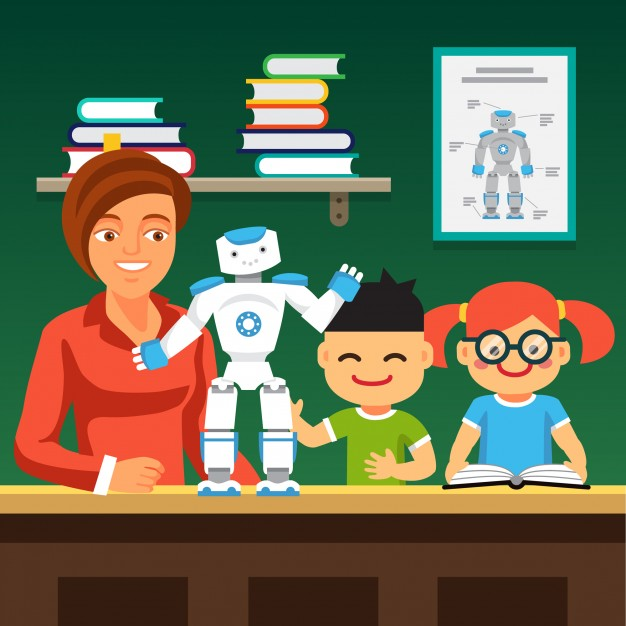
This is the time when everyone is aware of the magic that AI is doing all over the world. Yes, it is true and no one can deny the fact that AI is ruling all over the world almost in all the fields and is making our lives more exciting and autonomous. Like other fields, it is playing an important role in the field of education.
According to a survey, Artificial Intelligence (AI) recently started to penetrate into other industries in China. It was forecasted that by 2022 the Chinese market size of online education aided by artificial intelligence would amount to around 70.3 billion yuan.
Before I get a deep dive into the fact that what actually is the future of Ai in education, I would like to explain a little about Artificial intelligence.
What is Artificial Intelligence?

AI has the ability of a computer-controlled device to perform tasks in a human-like manner. As indicated by the author, human-like qualities include mental processes like reasoning, meaning-making, generalization, and learning from past experiences.
There have been mind-blowing developments in the evolution of AI and the remarkable role it has played in human lives. Recently, there have been some concrete examples of AI being capable of learning how to think like a human. These examples have even demonstrated that AI-based applications, in some cases, can even function as better as humans. You can hire AI developers in India for developing some awesome apps.
Now, it’s time to come on the point quickly and discuss the various pointers which reflect the importance of AI in education. Let’s have a look at them:
1. Adaptive Learning, Personalization and Learning Styles
Adaptive learning emerges as the focal point of AI research in the educational context. This theme indicates that AI implementations in education intend to provide learning spaces that meet the learner's needs and provide learning opportunities according to the learning preferences of the learners. That is, rather than adopting a “one size fits all” approach, the use of AI in education allows for tailored learning by positioning the learners at the center of the learning environments.
2. Expert Systems and Intelligent Tutoring Systems
An expert system (ES) can be defined as a program designed to emulate and mimic human intelligence, skills, or behavior, while an intelligent tutoring system (ITS) can be defined as a program that aims to provide immediate and customized instruction or feedback to learners. ES (Collins, 2018) and ITS are terms that are at the forefront of the developments in AI research (Burns & Parlett, 2014). ES has started using advanced algorithms, while ITS has been able to provide human-like interaction with conversation style dialogues. The potentials of ES and ITS emerge from the idea that they can be used 24/7 to support, enhance, enrich, and amend learning processes.
3. Automating the Testing and Checking Process
As student testing plays an important role in many educational systems, many projects are trying to explore the use of AI for automatic test generation and assessment. Much of this work is aimed at automating summative assessment, with a promise of reducing teacher workloads.
A possible unintended consequence of this work is that high-stakes testing will be increasingly displaced by frequent low-stakes formative assessment, as the effort and cost required for assessment decreases.
Current AI systems are very good at combining evidence from complex and varied sources of data and using them for real-time pattern recognition. For example, student homework can relatively easily be checked and diagnosed by an AI system that has data on both individual student history and peer responses. Accumulated formative assessments could, therefore, to a large extent, make high-stakes testing redundant.
4. Analyzing Student's Behavior
AI is also beginning to be used to diagnose student attention, emotion, and conversation dynamics in computer-supported learning environments, for example for course development and management, in an attempt to generate optimal groups for collaborative learning tasks and to recognize patterns that predict student drop-out. To do this effectively, large datasets are needed for training the systems. As was pointed out above, this is a major technical bottleneck.
Student behavior also has to be actively monitored to provide feedback for learning. This creates technical needs to unobtrusively monitor students, for example, using video processing and remote eye tracking, with associated ethical and regulatory challenges. Ethically less problematic are systems that use less granular data to provide recommendations. For example, at UC Berkeley students can now get course recommendations using a system that relies on neural AI technologies originally developed for natural language processing and machine translation.
5. Individualized Feedback
AI systems store information about learners and can give feedback to learners about how they are doing both in terms of whether they have got something correct or not.
6. Supporting Collaboration
When students work collaboratively, Ai systems can be used to monitor some indicators of
collaboration and can, therefore, be used to both monitor and manage collaborative working
and learning.
7. Repetition, Drill, and Practice
Learning often requires repetition in order to consolidate knowledge or skills. AI systems can readily supply endless examples (without losing patience!) and therefore be used to consolidate knowledge and skills both for learners who are struggling and have not yet consolidated their knowledge or mastered a skill and for those who wish to practice.
8. Assessing and Monitoring Student Progress
AI systems store information about what students know and can do and what information
and resources have been presented to students as well as the skills they have practiced and
mastered. Teachers can readily have access to this information which can be presented for
individuals, particular groups, and the whole cohort. It can be used for a variety of purposes
which can save time if used effectively.
Final words
This is how I think I am somehow successful in making you aware of the role of AI in the field of education. I just can say that there are more benefits of AI in education and you can explore them by doing more research.
After going through the whole blog, if you find the role of AI in education really great then do implement it in your education system as soon as possible so that you can give a rich boost to your education business.
Yes, AI can bring a revolution to your education business if you choose the best AI service as AI is indeed the thrilling and amazing technology that needs to be handled by the skilled developers only. If you are really feeling like to find skilled developers then you can contact various eLearning development companies in India which can provide you the best service at the best cost.








